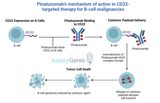Vibostolimab: Mechanism, Clinical Applications, and Research Potential in Oncology
Vibostolimab is a monoclonal antibody that targets TIGIT (T-cell immunoglobulin and ITIM domain), an immune checkpoint receptor that suppresses T-cell and natural killer (NK) cell activity in the tumor microenvironment. By blocking TIGIT, Vibostolimab enhances anti-tumor immune responses, particularly in combination with PD-1 inhibitors like Pembrolizumab. The biosimilar provides an affordable and accessible alternative, enabling wider adoption of TIGIT-targeted therapies.
This article explores the mechanism, clinical applications, and advantages of Vibostolimab biosimilar in cancer immunotherapy
1. Understanding TIGIT and Its Role in Cancer
What is TIGIT?
TIGIT is an immune checkpoint receptor expressed on T cells, NK cells, and regulatory T cells (Tregs). It interacts with ligands such as CD155 and CD112, leading to:
- Suppression of T and NK Cells: Reduces effector cell activity, enabling tumor immune evasion.
- Promotion of Tregs: Increases immunosuppressive activity in the tumor microenvironment.
Why Target TIGIT?
- Restoring Immune Function: Blocking TIGIT reactivates T cells and NK cells, improving anti-tumor immunity.
- Checkpoint Synergy: TIGIT inhibition complements PD-1/PD-L1 blockade, increasing treatment efficacy.
2. Vibostolimab Biosimilar: A Cost-Effective Option
Features of the Biosimilar
The Vibostolimab biosimilar replicates the efficacy and safety of the original antibody while offering a cost-effective solution.
3. Mechanism of Action
Step | Details |
|---|---|
TIGIT Binding | The biosimilar binds to TIGIT, preventing interaction with ligands CD155 and CD112. |
T-Cell Reactivation | Restores T-cell proliferation, cytokine production, and tumor-fighting ability. |
NK Cell Restoration | Enhances NK cell cytotoxicity against tumor cells. |
Tumor Microenvironment Reprogramming | Reduces Treg activity, fostering a pro-inflammatory and immune-activating environment. |
4. Clinical Applications
Non-Small Cell Lung Cancer (NSCLC)
Combination Therapy
- Effective when combined with Pembrolizumab, improving progression-free and overall survival.
- Particularly beneficial in advanced NSCLC with checkpoint resistance.
Melanoma
- Demonstrates promise in overcoming resistance to PD-1/PD-L1 inhibitors, enhancing tumor clearance.
Other Solid Tumors
5. Benefits of Vibostolimab Biosimilar
Enhanced Immune Activation
Reinvigorates T and NK cells, enabling robust immune responses against tumors.
Cost-Effective Access
Provides an affordable alternative to the original therapy, expanding global access to TIGIT-targeted treatments.
Synergistic Efficacy
Works effectively in combination with checkpoint inhibitors like Pembrolizumab, amplifying anti-tumor activity.
6. Challenges and Considerations
Resistance Mechanisms
- Tumors may activate alternative immune checkpoints or modify TIGIT expression to evade therapy.
Adverse Effects
- Immune-Related Adverse Events (irAEs): Includes mild fatigue, skin rash, and gastrointestinal disturbances. These are manageable with supportive care.
7. Comparison: Tiragolumab vs. Biosimilar
Feature | Tiragolumab | Biosimilar |
|---|---|---|
Target | TIGIT receptor. | TIGIT receptor. |
Mechanism | Blocks TIGIT-ligand interactions to enhance immune activity. | Blocks TIGIT-ligand interactions to enhance immune activity. |
Indications | NSCLC, melanoma, HNSCC, and gastric cancer. | NSCLC, melanoma, HNSCC, and gastric cancer. |
Efficacy | Proven in clinical trials. | Equivalent in preclinical and clinical studies. |
Cost | High | Reduced, improving accessibility. |
8. Future Directions
Expanded Indications
- Investigating efficacy in colorectal cancer, pancreatic cancer, and hematologic malignancies.
- Exploring applications in autoimmune diseases where TIGIT plays an immunosuppressive role.
Novel Combinations
- Checkpoint Blockade: Enhancing efficacy with anti-CTLA-4 therapies.
- Radiotherapy: Combining with radiation to increase tumor immunogenicity.
9. Summary Table
Aspect | Details |
|---|---|
Target | TIGIT, a checkpoint receptor suppressing immune activity in tumors. |
Primary Use | Treating TIGIT-expressing cancers such as NSCLC, melanoma, and HNSCC. |
Mechanism of Action | |
Biosimilar Benefits | Affordable, accessible, and clinically equivalent to Vibostolimab. |
Conclusion
The Vibostolimab biosimilar represents a significant advancement in cancer immunotherapy. By targeting TIGIT, it restores immune cell function, offering new hope for patients with advanced cancers. As a cost-effective alternative, the biosimilar broadens access to TIGIT-targeted therapies, improving outcomes worldwide.
References
- Chauvin, J.M., et al., 2015. TIGIT and its role in cancer immunotherapy. Cancer Cell, 26(5), pp.785-792.
- ClinicalTrials.gov, 2023. Studies on Vibostolimab and biosimilar therapies. Available at www.clinicaltrials.gov.
- European Medicines Agency (EMA), 2023. Guidelines for biosimilar development in immunotherapy. Available at www.ema.europa.eu.
- Rodriguez-Abreu, D., et al., 2021. Vibostolimab and PD-L1 blockade in NSCLC: Clinical outcomes. Journal of Clinical Oncology, 39(15), pp.1301-1310.
- Johnston, R.J., et al., 2014. TIGIT as a therapeutic target: Mechanistic insights and clinical advances. Trends in Immunology, 35(9), pp.450-462.
Recent Posts
-
Tigatuzumab Biosimilar: Harnessing DR5 for Targeted Cancer Therapy
Tigatuzumab is a monoclonal antibody targeting death receptor 5 (DR5), a member of the …17th Dec 2025 -
Alemtuzumab: Mechanism, Applications, and Biosimilar Advancements
Alemtuzumab is a monoclonal antibody targeting CD52, a glycoprotein highly expressed on …13th Jan 2025 -
Pinatuzumab: Advancing Cancer Research and Therapeutics
Pinatuzumab vedotin is an antibody-drug conjugate (ADC) targeting CD22, a cell surface …13th Jan 2025




